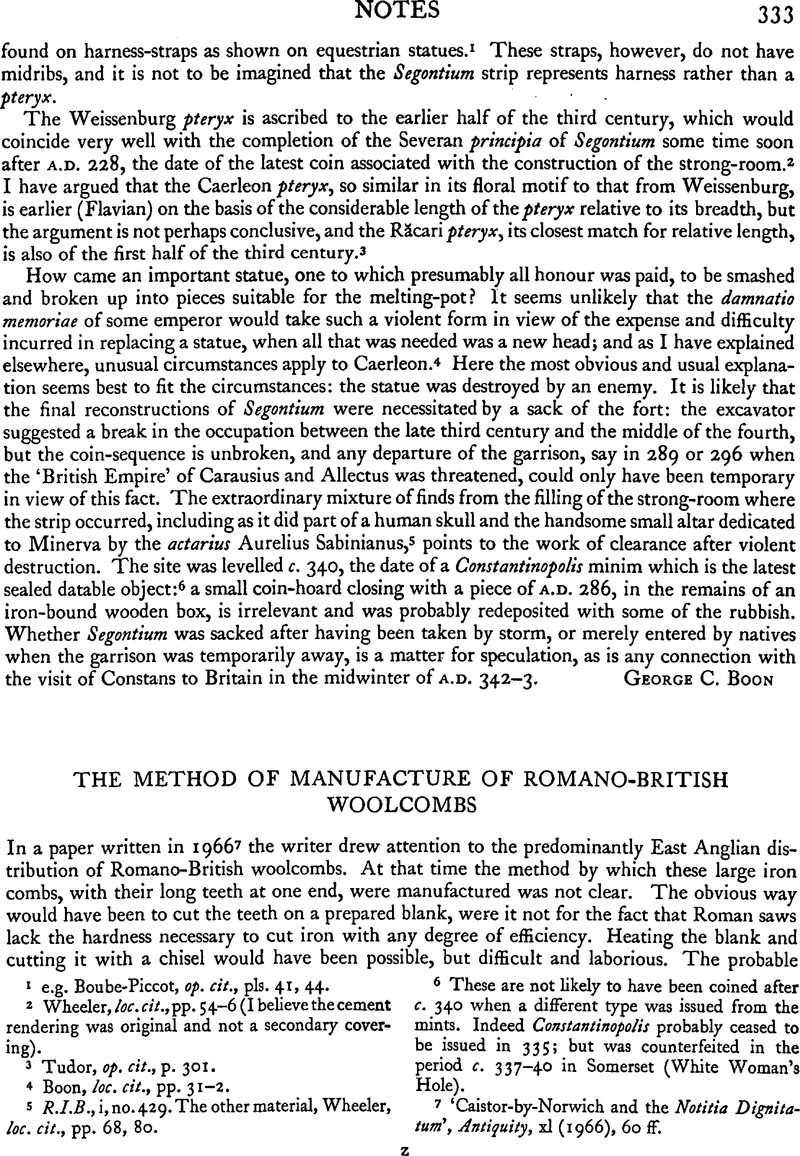No CrossRef data available.
Article contents
The Method of Manufacture of Romano-British Woolcombs
Published online by Cambridge University Press: 29 November 2011
Abstract

- Type
- Notes
- Information
- Copyright
- Copyright © The Society of Antiquaries of London 1972
References
page 333 note 7 ‘Caistor-by-Norwich and the Notitia Dignitatum’, Antiquity, xl (1966), 60 ff.Google Scholar
page 334 note 1 ‘Découverte d'un peigne en fer à Martizay (Indre)’, Revue Archéologique du Centre, t. vii, fasc. 3 (1968), 195 ffGoogle Scholar. I am indebted to Mr. G. C. Boon, F.S.A., for drawing my attention to this paper. Soubrier also lists combs from Compiègne (1), Vertault (3), Alésia (1), and Newel, near Trèves (1). All of these are double-ended, except for one of those from Vertault (Soubrier, photo no. 7) which has teeth at one end and a broad tang at the other—an apparently unique type, but one which has analogies with the sockets of the English combs. All of these combs should be added to the list in J. P. Wild, Textile Manufacture in the Northern Roman Provinces, p. 123, as should a double-ended comb from Aquileia (Catalogo: Museo della Civilta Romana (1958), p. 618) and another from Liedana, Spain (Excavaciones en Navarra, ii (1947–51) (1956), pl. 11)Google Scholar, which Mr. G. C. Boon has drawn to my attention. A double-ended comb from Augst has an inserted side tooth similar to the English combs (Mutz, A. in Provincialia (ed. E., Schmidetal.) (1968), 165).Google Scholar
page 335 note 1 The woolcombs known to the writer from Britain are from:
(a) with teeth at one end only:
1. Caistor-by-Norwich (Caistor St. Edmund), Norfolk, I comb in Norwich Castle Museum (Arch. News Letter, 6, no. II (1960), 262Google Scholar; Antiquity, xl (1966), 62 and fig. 2).Google Scholar
2. Icklingham, Suffolk. 2 combs, one in Moyse's Hall Museum, Bury St. Edmunds (our fig. 1), the other in Mildenhall Museum (Arch. News Letter, 6, no. 11 (1960), 262).Google Scholar
3. Ixworth, Suffolk. I comb in Ipswich Museum (our fig. 1) (Antiquity xl, (1966), 62).Google Scholar
4. Worlington, Suffolk. 2 combs in Museum of Archaeology and Ethnology, Cambridge (Proc. Camb. Antiq. Soc. xlix (1956), 89, pl. VIIb).Google Scholar
(b) with teeth at both ends:
1. Baydon, Wilts. I comb in Devizes Museum (Devizes Museum Cat. ii, 194, pl. LXII, 3).
2. Ewell, Surrey. Fragment (information from Mr. M. W. Bishop). A radiograph of this comb shown me by Mr. Bishop failed to reveal if the teeth were inset, but did make clear that one of the edge-teeth had been inserted with a triangular tongue as in the Ixworth and Icklingham combs.
3. Great Chesterford, Essex. I comb in the British Museum (Dept. of Prehistoric and Romano-British Antiquities. 1964.7–2.41).
(c) fragments:
London. Fragments of two combs in the Guildhall Museum from:
(i) Bank of England site (13764).
(ii) Walbrook Valley or Bank of England site (24696). Although the size of these fragments makes certainty difficult they probably had teethon one side only. (Information from Mr. Max Hebditch, F.S.A.)




